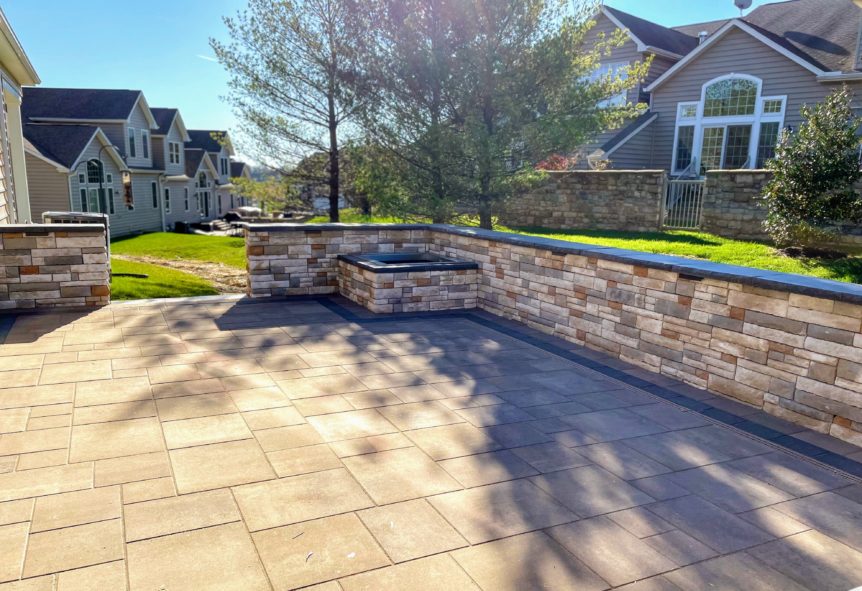What’s the best type of patio, paver or concrete? If you are considering installing or replacing a patio on your property, one very important factor to consider is the type of medium for building the patio. There are significant differences between the two in return on home value, aesthetic, durability, and longevity. We will discuss the differences between the two most common types of patios and walkways installed in our part of Maryland, concrete and paver.
Installation & Maintenance
Concrete patios can typically be installed in one day of work barring any significant grading concerns. Paver patios often take a couple days because of the amount of material handling and individual placement of intricate patterns. The extra labor contributes toward the higher cost of pavers.
Maintenance of concrete is generally easier. It should be cleaned and resealed every couple of years to maintain a clean look, especially because concrete tends to absorb stains. Cracks should be filled to prevent weeds from establishing. Pavers are typically pre-sealed but some can be cleaned and sealed every few years after installation. Pavers need regular maintenance to prevent accumulation of dust and prevent weeds from establishing in the gaps.
WINNER: Concrete
Durability
In Maryland, we go through the winter time ground freeze and thaw cycles. Because of that, there is a natural shifting, sinking, and expansion in the soil beneath the subgrade of a patio. In order to account for that, concrete patios must have expansion joints placed in them to reduce cracking. But even with a properly installed subgrade and expansion joints, concrete is still very prone to cracking, and eventually will crack over time. Minor cracks can be filled, but major cracks require a full demo and reinstallation.
Pavers, on the other hand, are independent of each other with gaps placed between them, which tolerates the freeze/thaw expansion. Cracking is extremely unlikely with pavers due to natural weather conditions. Because of this, pavers last much longer.
When enduring pressure, concrete can withstand roughly 2,500 psi, while pavers can withstand up to 8,000 psi. That means users have to be careful with heavy vehicles and equipment usage on concrete.
WINNER: Pavers
Aesthetic
Concrete can come in a variety of finishes, including brushed, stamped, and stained varieties. However, pavers come in an endless assortment of patterns, colors and textures and offer a much more high-end look. Pavers are much easier to match with the existing color and architecture of a home. Once concrete cracks, its appearance is permanently damaged, while pavers are very unlikely to crack. In the event a paver cracked, it could be individually replaced.
WINNER: Pavers
Longevity
On average, concrete will last approximately 25 years before total replacement is needed. Pavers, on the other hand, can last 50-100 years when well maintained and not subjected to intense usage.
WINNER: Pavers
Return on Investment
No doubt you’d like to see a return on investment you get when spending the money for a new patio. To note, concrete is significantly cheaper to install than pavers. Pavers generally cost 3-4x more per square foot to install than concrete.
Because of the durability, aesthetic, appearance and longevity of paver patios, pavers bring an increased return on investment, both in instantaneous curb appeal and when you factor in replacement costs over time. The vast majority of 20-year homeowners will never have to replace their newly installed pavers patios while they live at the house.
WINNER: Pavers
Chesapeake Landscapes designs and builds custom patios and walkways, including paver patios in Harford County, Eastern Baltimore County and Western Cecil County, MD. Schedule an appointment with a designer here!
Secure your position on the calendar so you don’t have to wait!


